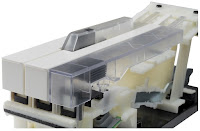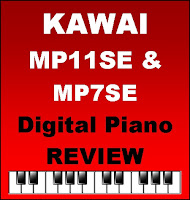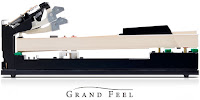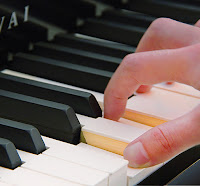🎹 UPDATED REVIEWS – Feb 1, 2023 – Kawai MP7SE and MP11SE | The Kawai piano company has had these newer models out for a while which replaced their previous MP7 & MP11 stage pianos. The newer versions are called the MP7SE piano-orchestra ($2199 internet discount price) and the MP11SE grand piano model ($3499 internet discount price). Both of these models have a few very important upgrades over the previous versions which I will explain below.
Kawai is a famous piano company headquartered in Hamamatsu, Japan and all they make are acoustic and digital pianos and are regarded in the top 3 of all digital & acoustic piano brands. They build hand-made 9 foot concert grand pianos all the way down to $700 portable digital pianos and have made a big name for themselves worldwide. Schools, universities, recording studios, piano teachers, pro musicians churches, and many others own and play Kawai pianos. In fact, Kawai has proprietary innovations they use in their acoustic and digital pianos that no one else has which puts them ahead of the pack in many cases. The Kawai name has a higher resale value than most and they are overall very reliable instruments.
 OK, so what is different in these newer models as compared to the previous models? The things that ARE new are what I consider to be the most important features in a piano and that is new upgraded key
OK, so what is different in these newer models as compared to the previous models? The things that ARE new are what I consider to be the most important features in a piano and that is new upgraded key

actions in the MP7SE along with new piano chip sound realism, and the same new piano sound chip is in the MP11SE along with more responsive pedaling because of a proprietary new optical sensor triple pedal system. I have played both of these models thoroughly and am impressed with what Kawai has done. Kawai currently has another model digital piano called the ES920 stage/home

piano ($1799 internet price) that uses the MP7SE key action and that action is called the RH3 key action.
 The MP11SE key action has not changed at all from the previous model (which is a good thing) and it still has the very popular and well regarded Kawai “Grand-Feel” wood key action which has longer individually installed keys that offers a different and more precise fulcrum and pivot point than the MP7SE RH3 key action. The longer wooden key not only moves up & down much more like a real full size acoustic grand piano (it can be difficult to tell the difference it’s so good), but the transition in key weight and finger pressure needed to press the key down from one key to the next on the MP11SE is almost seamless. It feels pretty much the same whether pressing the white keys, black keys, playing towards the back of the keys or front of the keys, the transitions are really smooth and realistic. Even the black wooden keys have an organic wood feel on the sides of the keys just like a real grand. I know many people who own and play great acoustic grand pianos such as Steinway, Kawai, etc and they buy MP11’s so they can practice with headphones so as to not disturb other people in the home, which they obviously cannot do on a real acoustic piano. The MP11SE key action is quiet and expressive and that’s what advanced players require of a digital piano so they can practice in privacy and yet still enjoy their piano playing.
The MP11SE key action has not changed at all from the previous model (which is a good thing) and it still has the very popular and well regarded Kawai “Grand-Feel” wood key action which has longer individually installed keys that offers a different and more precise fulcrum and pivot point than the MP7SE RH3 key action. The longer wooden key not only moves up & down much more like a real full size acoustic grand piano (it can be difficult to tell the difference it’s so good), but the transition in key weight and finger pressure needed to press the key down from one key to the next on the MP11SE is almost seamless. It feels pretty much the same whether pressing the white keys, black keys, playing towards the back of the keys or front of the keys, the transitions are really smooth and realistic. Even the black wooden keys have an organic wood feel on the sides of the keys just like a real grand. I know many people who own and play great acoustic grand pianos such as Steinway, Kawai, etc and they buy MP11’s so they can practice with headphones so as to not disturb other people in the home, which they obviously cannot do on a real acoustic piano. The MP11SE key action is quiet and expressive and that’s what advanced players require of a digital piano so they can practice in privacy and yet still enjoy their piano playing.
So what else is different and improved on these 2 new models? Well, both of them have Kawai’s top model piano sound chip with extended memory piano sampling. This piano sound chip offers a noticeably more natural and responsive piano tonal dynamic range and more organic elements of a real acoustic grand. There is a distinct difference in piano sound realism in these new models for the acoustic piano sounds as compared to the previous models. This change is on the MP7SE and MP11SE and the new piano sound chip comes from the Kawai home digital piano model called the CA59 which sells for $3799. Among other things this new piano sound chip offers 4 distinct individual sampled grand and upright piano sounds along with additional variations of those sounds so there is plenty of acoustic piano variety on the new models which is a welcome upgrade. It also offers precise piano editing control with the popular Kawai Virtual Technician feature that has many editing parameters to customize your piano sounds from within the piano. Kawai also has created a dedicated app for your tablet so you can more easily and intuitively make those custom Virtual Technician changes to your sounds and then save them.
The other upgrades and changes on these newer models are that the MP7SE & MP11SE now both have redesigned side panels that are polished black wood rather than the more traditional dark mahogany wood tone side panels that were in the previous models. This is a more subjective change and I like both colors but

the new black panel design which is also more flush with the keyboard itself along with the black color does make them look sleeker with a matching look to the rest of the piano. The new side panel redesign also added about 3 lbs more weight to the MP11SE. The other and last change to mention is that the new MP11SE has a redesigned proprietary and upgraded triple pedal unit called the GFP-3 as compared to the previous model pedal unit on the MP11.
Apart from the changes I just mentioned between the previous MP7 & MP11 models and these newer ones, everything else is identical in terms of function, features, digital controls, user interface…all of these things are the same and have ![]() not changed. Everyone that I know of (and there are many) who had purchased the previous models was very satisfied by their experience of those models and enjoy playing them. The main things that shoppers of digital pianos want to be sure of is that they will enjoy the “piano playing experience” of the model they have chosen and the MP7SE & MP11SE certainly rise to the occasion for most people. With these upgraded newer key actions, piano sound chip, and pedaling (MP11SE) in the new models, these pianos are now more realistic than ever when it comes to replicating what a real quality acoustic piano does when you play it. Achieving a higher quality of piano authenticity is always a good thing and I believe that is what Kawai has done here.
not changed. Everyone that I know of (and there are many) who had purchased the previous models was very satisfied by their experience of those models and enjoy playing them. The main things that shoppers of digital pianos want to be sure of is that they will enjoy the “piano playing experience” of the model they have chosen and the MP7SE & MP11SE certainly rise to the occasion for most people. With these upgraded newer key actions, piano sound chip, and pedaling (MP11SE) in the new models, these pianos are now more realistic than ever when it comes to replicating what a real quality acoustic piano does when you play it. Achieving a higher quality of piano authenticity is always a good thing and I believe that is what Kawai has done here.
I recommend you read my previous reviews of the prior MP7 and MP11 at the links below and then you’ll know (if you don’t already) what these new versions actually do in terms of functions, features, and their ability to offer a very satisfying user experience with being able to control those pianos in ways that make playing keyboard/piano very enjoyable. I highly recommend these newer upgraded “SE” models and have had great enjoyment playing and listening to them. By the way, just so everyone knows, I do try to look for negative things that I don’t like about new digital pianos when they come out and I mention these things if and when they come up. But aside from the fact that piano sound, key action, and pedaling are generally a bit subjective and that some people may like or dislike one or more of those things as compared to someone else, I really have nothing to complain about on these newer current models and in fact am very impressed overall.
If you want more info on new digital pianos and LOWER PRICES than internet discounts, please email me at tim@azpianowholesale.com or call direct at 602-571-1864.





















Hey Tim, how would rate the action of the MP7SE? Is the RH3 equivalent to say the Roland PHA-50 or Yamaha GH3X?
Tim, thanks for your up-to-date and knowledgeable review of the new SE models. Always appreciate your detailed information. You mentioned the new counterweights in the MP7SE; I guess the MP11 already had that feature?